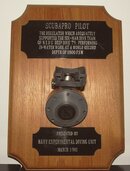You are using an out of date browser. It may not display this or other websites correctly.
You should upgrade or use an alternative browser.
You should upgrade or use an alternative browser.
Your favourite second stage and *why?
- Thread starter buddhasummer
- Start date
Please register or login
Welcome to ScubaBoard, the world's largest scuba diving community. Registration is not required to read the forums, but we encourage you to join. Joining has its benefits and enables you to participate in the discussions.
Benefits of registering include
- Ability to post and comment on topics and discussions.
- A Free photo gallery to share your dive photos with the world.
- You can make this box go away
halocline
Contributor
The thing I never understood about that award is that 2nd stages should basically basically function the same at 30 feet or 300 feet. They are taking pressure at X over ambient and reducing/delivering it at ambient. X doesn't change. It's the 1st stage that has to work harder at depth, because it is taking tank pressure (which does not change with depth) and reducing/delivering pressure of IP plus ambient. That, of course, does change dramatically with depth. At 300 ft, the 1st stage is flowing 8 times the amount of air as at the surface, from the same supply pressure, to keep IP steady over ambient. The 2nd stage is also flowing more air, but not in relation to what it is being fed. It's strictly a viscosity issue.Yes. Apparently the Pilot is pretty BA.
Maybe the big deal over the pilot's deep water performance has to do with the fact that 1st stages (not to mention the tank valve) simply can't keep up with that type increased demand, and as such, having a 2nd stage capable of flowing huge volumes of air with very low cracking effort can compensate for the inevitable drop in dynamic IP at great depths.
The Pilot is spooky in use, Air 1 is almost as good but greatly simplified design but the things were hard to teach to the average quick tech, often the “best” designs fall to the “good enough” designs.
FlyingSeaMonke
Registered
I'm in love with my D400 - especially for photography.
I spent 5 minutes upside down in Indonesia trying to get the perfect shot on a pygmy seahorse and it breathed easy and dry the whole time. My HOG regs would have been waterboarding me if I tried that.
I'm in the market for new regs now that we're getting into tech so threads like this are great, thanks!
I spent 5 minutes upside down in Indonesia trying to get the perfect shot on a pygmy seahorse and it breathed easy and dry the whole time. My HOG regs would have been waterboarding me if I tried that.
I'm in the market for new regs now that we're getting into tech so threads like this are great, thanks!
2) S620ti smooth once set to low -/+
3) S600 nice easy breath
Is the difference detectable between these two for you?
I will say yes, if you adjust the VIVA control and IRC knob just right. I use the S620ti with MK17 EVOIs the difference detectable between these two for you?
My son uses the S600 with MK17 EVO and loves it.
- Messages
- 17,699
- Reaction score
- 9,950
- Location
- Somewhere between here and there
- # of dives
- 2500 - 4999
The thing I never understood about that award is that 2nd stages should basically basically function the same at 30 feet or 300 feet. They are taking pressure at X over ambient and reducing/delivering it at ambient. X doesn't change. It's the 1st stage that has to work harder at depth, because it is taking tank pressure (which does not change with depth) and reducing/delivering pressure of IP plus ambient. That, of course, does change dramatically with depth. At 300 ft, the 1st stage is flowing 8 times the amount of air as at the surface, from the same supply pressure, to keep IP steady over ambient. The 2nd stage is also flowing more air, but not in relation to what it is being fed. It's strictly a viscosity issue.
Maybe the big deal over the pilot's deep water performance has to do with the fact that 1st stages (not to mention the tank valve) simply can't keep up with that type increased demand, and as such, having a 2nd stage capable of flowing huge volumes of air with very low cracking effort can compensate for the inevitable drop in dynamic IP at great depths.
Big brain.
PEDiver
Contributor
1) G250
2) G200B
3) A700
I love my Scubapro regs…I have not found anything that breathes better than a G250 (no matter what depth) and I’ve tried numerous other brands/models over the years.
2) G200B
3) A700
I love my Scubapro regs…I have not found anything that breathes better than a G250 (no matter what depth) and I’ve tried numerous other brands/models over the years.
ElCarlos
Registered
My Mares Abyss. Because it has no levers and knobs to adjust anything. It just works.
Similar threads
- Replies
- 63
- Views
- 5,547
- Replies
- 23
- Views
- 4,005
- Replies
- 2
- Views
- 613
- Replies
- 25
- Views
- 1,639
- Replies
- 7
- Views
- 444




